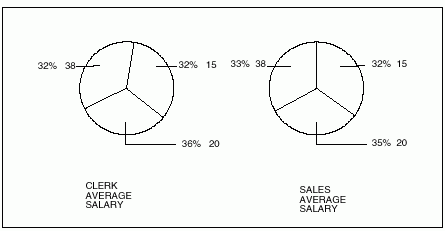
Pie charts are unique in that they do not have a typical X-axis and Y-axis. Compare the report in Figure 135 and the pie chart in Figure 136 to see how QMF displays data on a pie chart.
Figure 135. This report shows department salary averages.
+--------------------------------------------------------------------------------+ | <--------- JOB ----------> | | <- CLERK --> <- SALES --> <- TOTAL --> | | AVERAGE AVERAGE AVERAGE | | DEPT SALARY SALARY SALARY | | ---- ---------- ---------- ---------- | | 15 12383.35 16502.83 13756.51 | | 20 13878.68 18171.25 15309.53 | | 38 12482.25 17407.15 14944.70 | | ======== ======== ========= | | 12914.76 17372.10 14697.69 | | | | | +--------------------------------------------------------------------------------+
Figure 136. The pie chart displays the same data.

Each numeric column (called Y-data columns) produces a separate pie. QMF displays column data as labels attached to the pie slices. It displays column headings as titles for the pies.
Because each numeric column on a report produces a separate pie, you probably won't want to use a pie chart to display data from reports with more than two numeric columns.